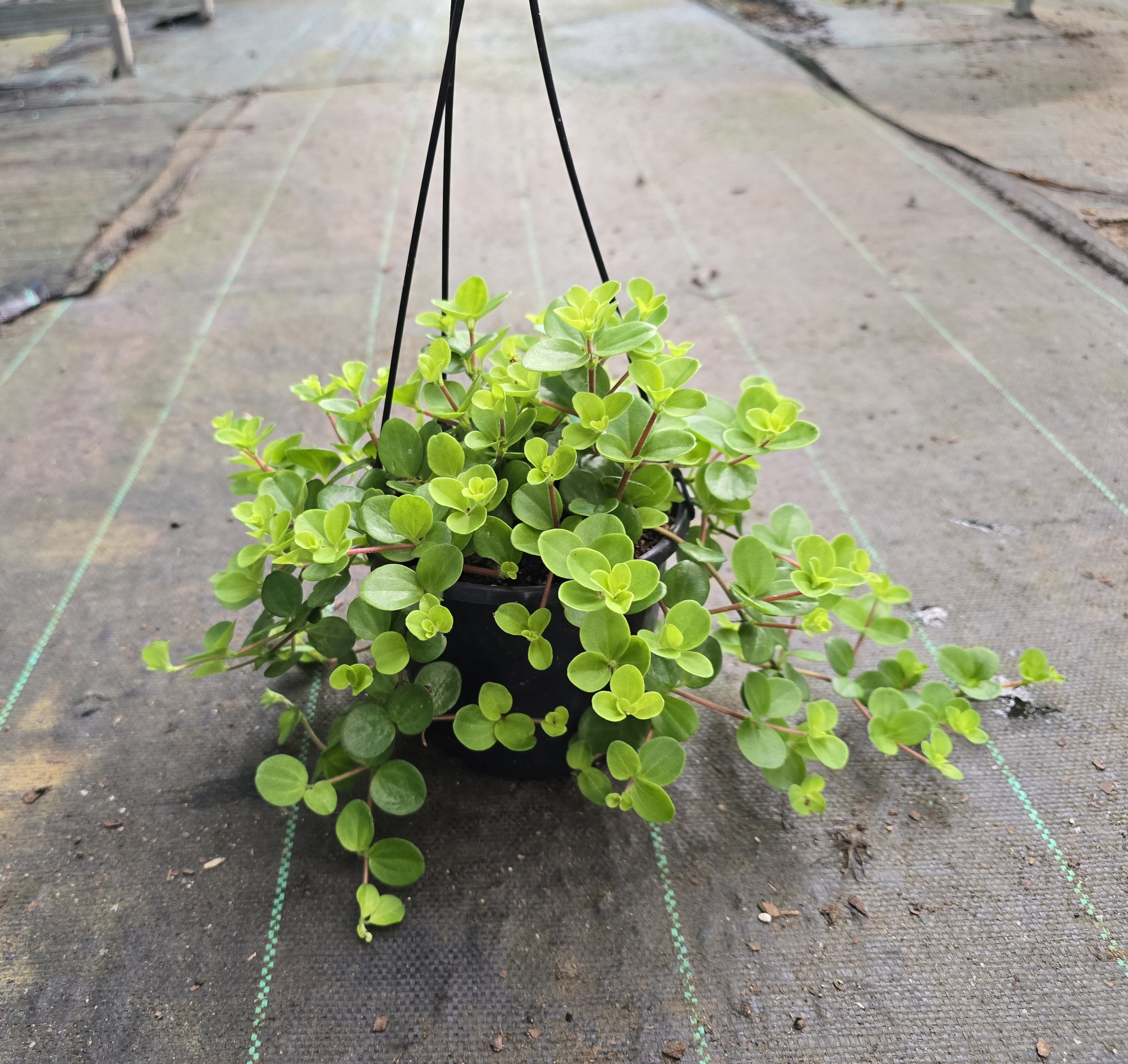 Image 1 of 1
Image 1 of 1


Peperomia rotundifolia
🌿 Peperomia rotundifolia (Trailing Jade)
Common Names:
Trailing Jade, Round Leaf Peperomia, Jade Necklace
Family:
Piperaceae (Pepper family)
Native Range:
South America – especially Brazil and surrounding regions.
📏 Physical Description
Growth Habit:
A small, trailing or creeping succulent-like plant, ideal for hanging baskets, terrariums, or tabletop planters.Leaves:
Tiny, round to oval-shaped, fleshy leaves, light to medium green in color.
Leaves grow in pairs along thin, trailing stems that can reach up to 30–50 cm (12–20 inches) in length.Stems:
Slender and flexible, often cascading over pot edges.Overall Look:
Soft, lush, and spilling—giving a gentle, draping effect when grown in hanging pots.
🌸 Flowers
Appearance:
Tiny, non-showy, spike-like flowers (common to many Peperomias).
Usually pale green to white and appear along thin stalks.Bloom Time:
Can flower sporadically throughout the year but not grown for its flowers—grown for its foliage.
🌱 Care and Cultivation
Light:
Prefers bright, indirect light, but can tolerate low light better than many other trailing plants.
Too much direct sun can scorch its delicate leaves.Watering:
Water when the top 2–3 cm of soil feel dry.
Being semi-succulent, it stores water in its leaves and is somewhat drought-tolerant.
Avoid waterlogging to prevent root rot.Humidity:
Loves moderate to high humidity, but can adapt to average household humidity.Soil:
Prefers a well-draining mix like a cactus or succulent mix blended with some peat or coco coir for light moisture retention.Temperature:
Optimal between 18–25°C (65–77°F).
Avoid temperatures below 10°C (50°F).Feeding:
Light feeder. Fertilize monthly during growing season (spring and summer) with a diluted liquid houseplant fertilizer.Propagation:
Easily propagated by stem cuttings. Simply cut a healthy stem, let it dry for a few hours, then plant it in moist soil.
✅ Common Uses
Ideal for hanging baskets, terrariums, tabletop displays, or as a ground cover in indoor dish gardens.
Often used as a pet-safe alternative to trailing pothos (Peperomias are generally non-toxic to pets).
✅ Potential Issues
Overwatering: This is the biggest killer. Let soil dry out between watering.
Legginess: Can happen in low light. Trim back to encourage bushier growth.
Pests: Generally pest-resistant but watch for fungus gnats, mealybugs, or spider mites if overwatered or stressed.
✅ Quick Care Summary
RequirementDetailsLightBright, indirect (tolerates low light)WaterLet soil dry slightly between wateringSoilWell-draining, light mixHumidityModerate to high (adapts well)Temperature18–25°C (65–77°F)PropagationEasy by stem cuttings
🌿 Peperomia rotundifolia (Trailing Jade)
Common Names:
Trailing Jade, Round Leaf Peperomia, Jade Necklace
Family:
Piperaceae (Pepper family)
Native Range:
South America – especially Brazil and surrounding regions.
📏 Physical Description
Growth Habit:
A small, trailing or creeping succulent-like plant, ideal for hanging baskets, terrariums, or tabletop planters.Leaves:
Tiny, round to oval-shaped, fleshy leaves, light to medium green in color.
Leaves grow in pairs along thin, trailing stems that can reach up to 30–50 cm (12–20 inches) in length.Stems:
Slender and flexible, often cascading over pot edges.Overall Look:
Soft, lush, and spilling—giving a gentle, draping effect when grown in hanging pots.
🌸 Flowers
Appearance:
Tiny, non-showy, spike-like flowers (common to many Peperomias).
Usually pale green to white and appear along thin stalks.Bloom Time:
Can flower sporadically throughout the year but not grown for its flowers—grown for its foliage.
🌱 Care and Cultivation
Light:
Prefers bright, indirect light, but can tolerate low light better than many other trailing plants.
Too much direct sun can scorch its delicate leaves.Watering:
Water when the top 2–3 cm of soil feel dry.
Being semi-succulent, it stores water in its leaves and is somewhat drought-tolerant.
Avoid waterlogging to prevent root rot.Humidity:
Loves moderate to high humidity, but can adapt to average household humidity.Soil:
Prefers a well-draining mix like a cactus or succulent mix blended with some peat or coco coir for light moisture retention.Temperature:
Optimal between 18–25°C (65–77°F).
Avoid temperatures below 10°C (50°F).Feeding:
Light feeder. Fertilize monthly during growing season (spring and summer) with a diluted liquid houseplant fertilizer.Propagation:
Easily propagated by stem cuttings. Simply cut a healthy stem, let it dry for a few hours, then plant it in moist soil.
✅ Common Uses
Ideal for hanging baskets, terrariums, tabletop displays, or as a ground cover in indoor dish gardens.
Often used as a pet-safe alternative to trailing pothos (Peperomias are generally non-toxic to pets).
✅ Potential Issues
Overwatering: This is the biggest killer. Let soil dry out between watering.
Legginess: Can happen in low light. Trim back to encourage bushier growth.
Pests: Generally pest-resistant but watch for fungus gnats, mealybugs, or spider mites if overwatered or stressed.
✅ Quick Care Summary
RequirementDetailsLightBright, indirect (tolerates low light)WaterLet soil dry slightly between wateringSoilWell-draining, light mixHumidityModerate to high (adapts well)Temperature18–25°C (65–77°F)PropagationEasy by stem cuttings